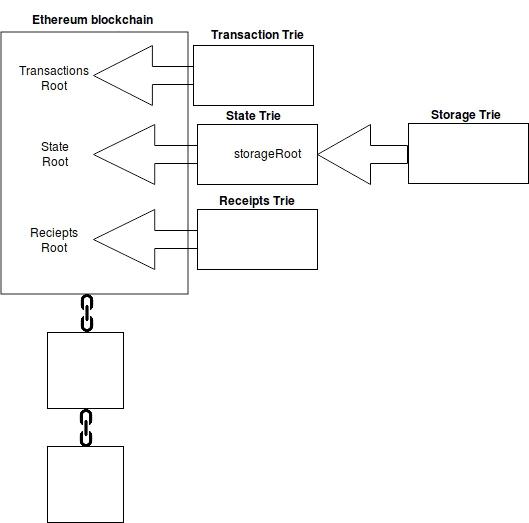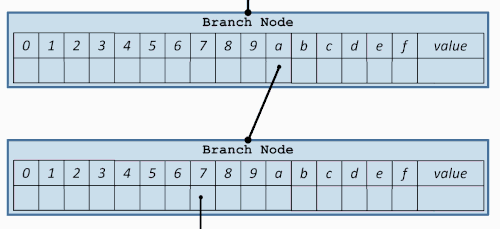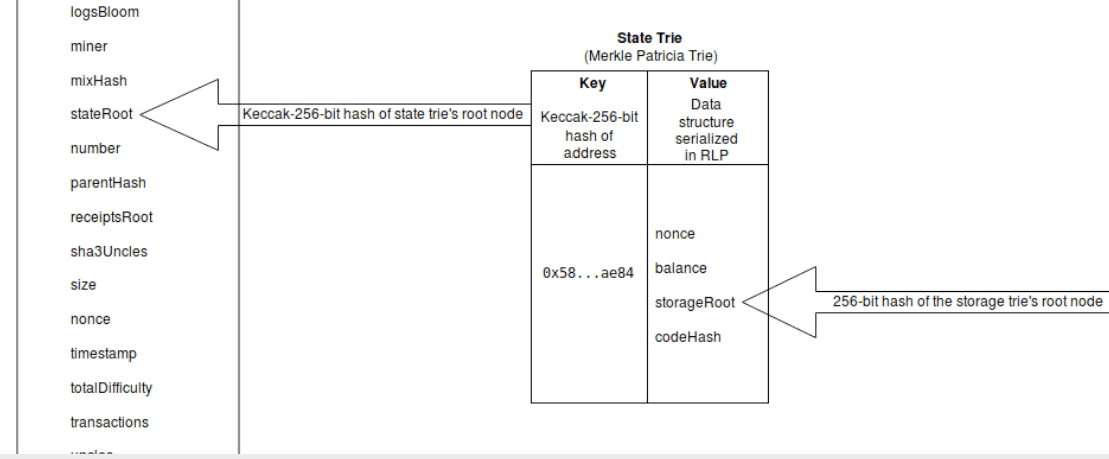Ethereum World State
Table of Contents
1. World State 简介
可以把区块链看做是一个分布式的状态机:所有节点从第一个区块中的创世状态开始,依次执行每个区块内的交易,这些交易会对状态进行操作(增加、删除、修改),由于所有节点执行的交易完全相同,执行顺序也相同,从而这个状态在所有节点也是完全一致,我们把这个状态称之为“世界状态”(World State)。
“世界状态”是区块链的核心,其它数据都是围绕“世界状态”而来。本文将从“世界状态”开始介绍 Ethereum 的数据存储结构。
2. State Trie(保存世界状态)
在 Ethereum Yellow Paper 的第 4.3 节介绍了区块头的结构定义,区块头一共包含了 15 个字段,这 15 个字段中 transactionsRoot/receiptsRoot/stateRoot 这 3 个字段分别记录着 3 个 Trie 的根,其中 stateRoot 就是世界状态对应 Trie 的根,一旦某区块被节点确认,则区块头所有信息(当然包括 stateRoot)也就无法被改变了,如图 1(摘自 https://medium.com/cybermiles/diving-into-ethereums-world-state-c893102030ed ) 所示。

Figure 1: 其中 stateRoot 是“世界状态”对应 trie 的根
State Trie 保存着 Ethereum 中每个帐户的信息,即很多 key-value 数据,具体为:
- key 是帐户的地址的哈希,即 Keccak256(address) 。
- value 记录着帐户的下面 4 个信息的 RLP 编码数据:
- nonce
- balance
- storageRoot(仅合约帐户才有,记录合约 Storage trie 的根,后面会介绍)
- codeHash
- nonce
当链发生 Reorganization 时,需要 Revert Block,这需要回到 State Trie 的某个历史状态,相关信息可参考:State Tree Pruning, by Vitalik Buterin
2.1. Modified Merkle Patricia Trie
图 2 一个简化版本的 State Trie 的示意图(摘自 https://ethereum.stackexchange.com/questions/268/ethereum-block-architecture )。它演示的是下面 4 个 key-value 对是如何保存在 State Trie 中的:
# key value a711355 45.0 a77d337 1.00 a7f9365 1.1 a77d397 0.12
这个简化版本中,key 仅占 35 个比特位,而 value 也仅编码了 balance 信息(完整版本中 value 编码了 nonce/balance/storageRoot/codeHash 这 4 个信息)。

Figure 2: 简化版本的 State Trie
Ethereum 中,State Trie 是一种 Modified Merkle Patricia Trie(简称 MPT)。MPT 有三种节点类型:
- Leaf Node,一个节点如果没有子节点,则称为 Leaf Node。Leaf Node 保存 2 个信息:[encodedPath, value],encodedPath 用于保存 key 中的部分 path,而 value 用于保存键值对的 value,例如在图 2 中最左边那个 Leaf Node 的 encodedPath 为 1355,而 value 为 45.0ETH。
- Branch Node,一个节点如果存在子节点,则是 Branch Node(也可能是 Extension Node,后面会介绍),Branch Node 保存 17 个信息:[v0 ... v15, vt ],由于 key 都是 16 进制,前 16 个 item 恰好足够保存 path 中的一项了,而最后一个 vt 用于保存键值对的 value,例如在图 2 中,如果要有一个 key 为 a7 键值对需要保存,则图中第 1 个 Branch Node 的 value 就会用到了。
- Extension Node, 如果连续几个 Branch Node 仅有一个子节点,则可以优化(压缩)为一个 Extension Node。 Extension Node 保存 2 个信息:[encodedPath, next-node],encodedPath 用于保存 key 中的部分 path,而 next-node 用于指向下一个节点。例如在图 2 中的第 1 个 Extension Node 可以看作是图 3 中两个连续 Branch Node 的优化。

Figure 3: 如果连续几个 Branch Node 仅有一个子节点,则可以优化(压缩)为一个 Extension Node
2.2. Storage Trie(保存合约数据)
合约中的所有数据,都是以 key-value 形式存储在 Storage Trie 中。 每个合约都对应一个 Storage Trie, 一个 Storage Trie 的根称为 storageRoot,它和 State Trie 的关系如图 4(改编自 https://medium.com/cybermiles/diving-into-ethereums-world-state-c893102030ed )所示。

Figure 4: Storage trie
Storage Trie 中的 key 和 value 分别是什么呢?合约中的数据可以看作是一个“大数组”,所有数据都保存在数组的某个 slot 中。
contract Storage {
uint pos0; // 对于固定大小的状态变量,从编号 0 开始,所以 pos0 的 slot 就是 0
// ......
}
Storage Trie 中的 key 是状态变量 slot 的哈希,即 Keccak256(slot);而 value 就是对应的状态变量的值。 使用 getStorageAt 可以查询合约中保存的数据。
3. Transactions Trie(保存交易数据)
每个区块都有一个 Transactions Trie,记录着区块中每个 Transaction 的下面信息(参考 Yellow Paper 的第 4.2 节):
nonce gasPrice gasLimit to value v,r,s
Transactions Trie 中的 key 是 RLP(transactionIndex),这里 transactionIndex 是交易在当前区块中的索引。
4. Receipts Trie(保存交易执行结果)
每个区块都有一个 Receipts Trie,记录着区块中每个 Transaction 的执行结果 (参考 Yellow Paper 的第 4.3.1 节):
status // 交易的最终状态 cumulativeGasUsed // 执行交易时,当前区块内的累计 gas 使用 bloom // Bloom filter composed from information in those logs logs // 交易执行时,合约产生的 event
Receipts Trie 中的 key 是 RLP(transactionIndex),这里 transactionIndex 是交易在当前区块中的索引。
注:Transactions Trie 和 Receipts Trie 和当前世界状态无直接关系,但它们记录着改变世界状态的交易的相关信息。